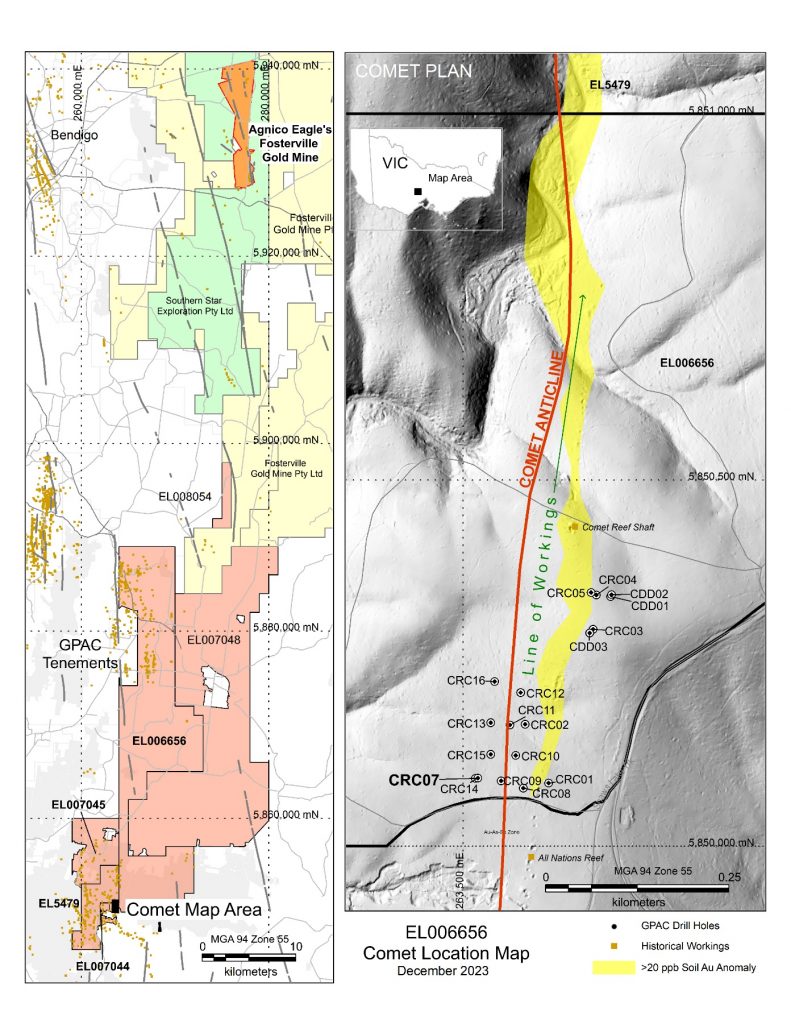
Canadian junior exploration company Great Pacific Gold (TSXV:GPAC) recently announced exciting results from drilling at its Lauriston gold project located in the state of Victoria, Australia.
A reverse circulation (RC) drill hole at the Comet prospect intersected a high-grade zone of gold mineralization. Drill hole CRC07 returned an intercept of 5 meters grading 166 grams per tonne (g/t) gold from 95 meters depth. This includes an even higher grade interval of 2 meters at 413 g/t gold. Within this zone, assays returned 1 meter at 468 g/t gold and 1 meter at 358 g/t gold.
According to Great Pacific’s announcement, follow-up sampling was conducted on the alteration halo surrounding the high-grade mineralized zone. It was expected that this halo might return anomalous but sub-economic gold values. However, assays surprised by returning an interval of 1-meter grading 13 g/t gold.
With these new halo assays, the total mineralized interval from 95 meters depth has now expanded to 8 meters grading 106 g/t gold. This includes the previously announced high-grade section of 5 meters at 166 g/t gold, which contains the bonanza grades of 413 g/t over 2 meters.
The Comet prospect where this discovery was made exhibits geological characteristics typical of epizonal orogenic gold deposits. The style of mineralization and minerals present – gold-arsenic-antimony – is similar to the extremely high-grade Fosterville mine owned by Kirkland Lake Gold, located elsewhere in Victoria.
At Comet, mineralization occurs within the Comet fault zone, which trends westward and dips steeply. This structure cuts Ordovician-aged slate and sandstone units that display folding into a series of north-south striking concertina shapes. The high-grade gold discovery hole is situated close to the Comet anticline fold structure that has been mapped at surface in the project area. This anticline is considered important in controlling the localization of gold within the fault zone.
The structural setting at Comet bears many similarities to the depositional environment of Fosterville’s exceptional gold endowment. Much anticipation will await drill testing of this new discovery at depth and along trend.
Great Pacific states that a diamond drill rig is being mobilized to site to follow up this discovery made by RC drilling. Diamond drilling is slated to resume at the Comet prospect in late January or early February 2022. Diamond drilling will allow for more detailed sampling and analysis of the high-grade structure.
In other company news, Great Pacific announced the appointment of Dr. Chris Muller to its Board of Directors, replacing John Lewins who will continue serving in an advisory role.
Dr. Muller brings over 20 years of exploration experience to Great Pacific, from work spanning diverse geological environments in Papua New Guinea, Mongolia, China, Ghana, Indonesia and Thailand. He currently serves as Executive Vice President, Exploration for K92 Mining, a rapidly growing gold producer in Papua New Guinea.
Some career highlights for Muller include involvement in discovery of additional porphyry deposits at the world-class Wafi-Golpu project in PNG, and recognition of the Blue Lake porphyry deposit which is now PNG’s 5th largest.
At K92, Chris Muller and his exploration team were recently awarded the Thayer Lindsley Award from the Prospectors & Developers Association of Canada for the Kora North discovery, judged the best global mineral discovery of 2021.
Great Pacific also announced it has granted 6,690,000 restricted share units and 2,215,000 incentive stock options in conjunction with new appointments, including Muller to the board. The options are exercisable at $0.95 per share for a five-year term from the grant date.
With positive early drilling results from the Lauriston project and the strengthening of its exploration leadership, Great Pacific Gold appears poised for an active 2022 further testing its Australian gold properties. The company will be one to watch as this recent high-grade discovery is followed up.
| HoleID | East | North | Azimuth (deg.) |
Dip (deg.) | From (m) | To (m) | Downhole Interval (m) |
Au g/t |
| CRC007 | 263517 | 5850093 | 92 | -66 | 95 | 103 | 8 | 106 |
| includes | 95 | 100 | 5 | 166 | ||||
| includes | 96 | 98 | 2 | 413 |
The 8m intercept uses a 0.6 g/t Au cut-off grade and no internal waste. The 5m intercept uses a 1.0 g/t Au cut-off grade and no internal waste, while the higher-grade included intercept of 2m uses assays of greater than 350 g/t Au and no internal waste parameter. True widths are not known. Additional drilling is required to determine true widths. The assays are not capped.



 Follow us on Twitter
Follow us on Twitter Become our facebook fan
Become our facebook fan










Comments are closed.